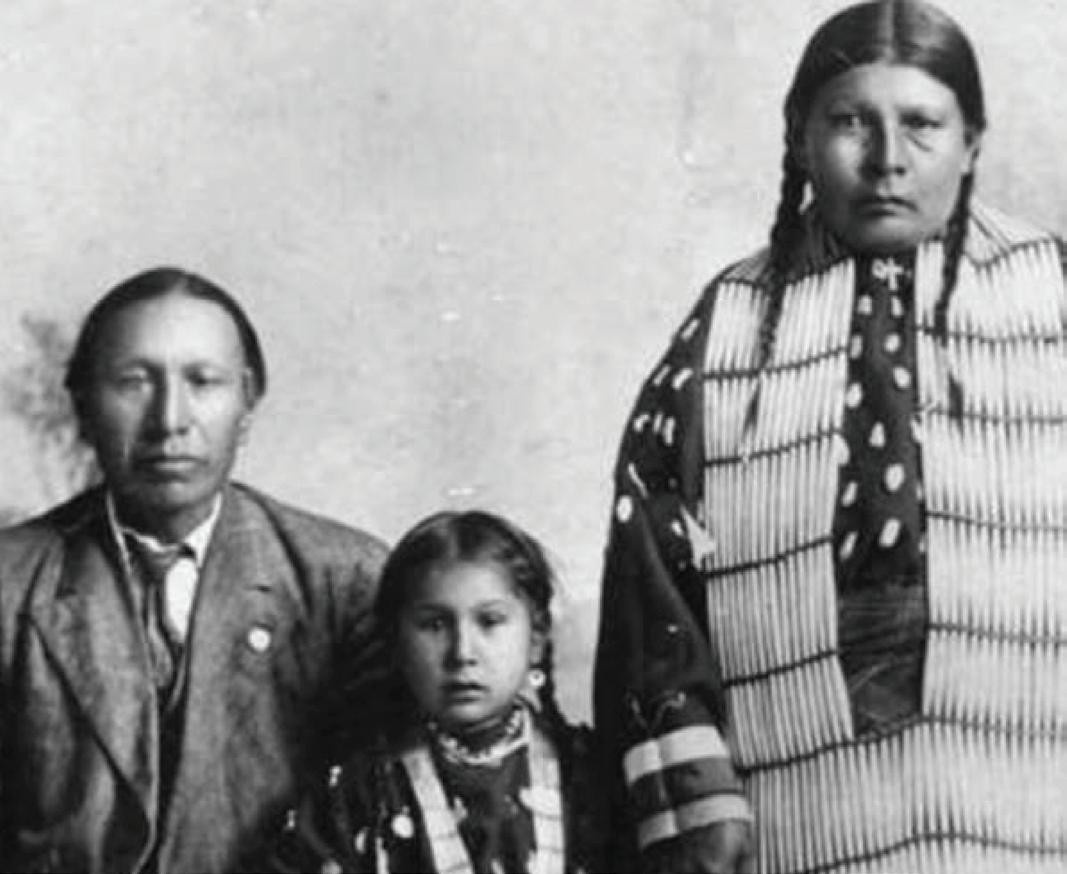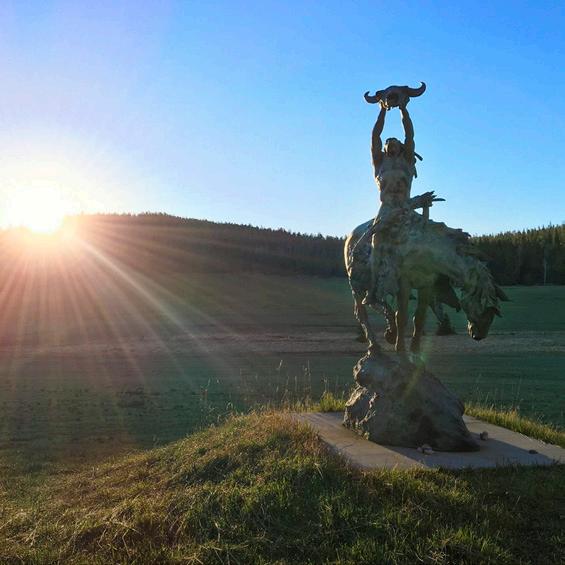
7 minute read
Nicholas Black Elk
NATIVE AMERICAN HERITAGE
1863 - 1950
Advertisement
Native American Evolutionist
Black Elk, the great Lakota spiritual healer, was born into the Oglala Lakota tribe of the Great Sioux Nation in December 1863 near the Little Powder River, in what is now the state of Wyoming.
His life as a spiritualist was foretold in a dream he had as a nine-year-old while he lay in a coma, gravely ill. In this vision he was taken by spirits into the clouds to meet with spiritual powers which he called grandfathers; these represented the six directions: North, South, East, West, earth and sky. These grandfathers gave him sacred objects representing each of the directions and the responsibility of maintaining their circle of life, which he called the "sacred hoop."
In the dream he was taken to what is now known as Black Elk Peak, which he described as the Center of the World; and from this vantage, he viewed the entire world, the two-legged, the four-legged, the winged ones, and those that swim. Then he saw his people were all dying; but when he rode through them he took the bright red stick, and at the center of the nation's hoop, he thrust it into the earth, saving them all.
The gifts he received from the spirits were the foundation for his teachings, which have been studied and praised by such intellectuals as Karl Jung and other philosophers, spiritualists, and mystics.
In the course of his growing up, his tribe experienced the opening of the Bozeman Trail which cut across the heart of
their best hunting grounds and fomented the Red Cloud’s War – the Lakota’s greatest victory over the US military, which abandoned its forts along the Trail. This defeat forced the US to sue for peace leading to the 1868 Treaty of Fort Laramie, which established the Great Sioux Reservation to include most of western South Dakota, and vast tracts in eastern Montana, western Nebraska and eastern Wyoming. What followed were years of devastation in which the 1868 Treaty was repeatedly broken as White pioneers scattered from the Oregon/ California Trails and began settling on Indian lands. Then the bison herds were hunted to near extinction in order to fill the insatiable demand for leather belting to drive new machinery in America’s Industrial Revolution back East, to feed crews of railroad workers and miners, and, not least in importance, to destroy the Indians’ food source as a means of subjugating them.

There was a massive build-up of a frontier army to ostensibly keep the peace between the Indians and white intruders on their lands. And in 1874, on a reconnaissance into the Black Hills, Custer’s troops discovered gold. Words spread immediately and a new mass incursion of prospectors and entrepreneurs ensued. This invasion into their most sacred area caused the Sioux and other tribes to prepare for possible warfare.
The Sioux rejected offers by the US Government to purchase the Black Hills, and new pressures were applied to force them to concede. What followed led to the most famous rout of the US military in the history of the West at the Little Big Horn on June 25th, 1876. At age thirteen, Black Elk participated in the action, as was expected of Lakota youth. A year later, young Black Elk learned of the death of his father’s cousin, Lakota Chief Crazy Horse. When Black Elk was eighteen, he went on his first vision quest where divine spirits reminded him of the duties of his first vision. By then, however, the practice of traditional religious ceremony or healing were forbidden by law. In 1886, Black Elk signed on to travel with Buffalo Bill Cody's Wild West Show to Chicago, New York, and Europe performing traditional Lakota dances and battle re-enactments. In 1888, he returned to the reservation in Pine Ridge, South Dakota and found his people worse off than when he left.
The Lakota had endured terrible retribution at the
hands of the US government: they were confined to ever-shrinking reservations, and their food sources were destroyed. They were a destitute and desperate people, which led many to embrace the Ghost Dance movement – a religious belief that if they practiced the Ghost Dance, the Whites would disappear and their buffalo herds would return, and they would once again be a great nation.
This movement alarmed the White settlers and the US Government dispatched the Army to put down what they described as a mass Indian insurrection. This culminated in the Wounded Knee Massacre of 1890. Black Elk saw the horrible scene of the massacre, a sight that would haunt him for life as a precursor to the fate of the tribe and what he saw as his failure to carry out the mandate of his vision.

In 1902, his wife Katie War Bonnet converted to Catholicism, and upon her death in 1904 he was baptized and chose the name Nicholas. Soon after, he became a Catechist and on reservations in South Dakota Black Elk proselytized, led prayer meetings, and served in the absence of circuit-riding Priests. Having converted over 400 Indian people, he earned the sobriquet "St. Paul of the Sioux."
Beginning in 1934, Black Elk worked organizing Indian shows in the Black Hills. Unlike the Wild West shows which glorified warfare between Indians and the military, Black Elk's shows were used primarily to teach tourists about Lakota culture and traditional sacred rituals.
Nicholas Black Elk died in 1950 and is buried in a simple grave in the village of Manderson on the Pine Ridge Indian Reservation. His legacy is marked by many honors. In 1999, a panel of experts listed Black Elk Speaks as one of the top ten spiritual books of the twentieth century. The federal government recently renamed Harney Peak as Black Elk Peak. Internationally, Black Elk is the most famous American Indian of the twentieth century, and almost certainly the world’s most well-known South Dakotan. His life and teachings promote the ongoing ecumenical dialogue between different faiths, particularly Christianity and American Indian spiritual traditions. The Catholic Church has begun the process of canonizing Black Elk.
NOMINATED BY CHARLES TRIMBLE
Honoring the life and legacy of NICH OLAS BLACK ELK





CONGRATULATIONS RECOGNITION BY Stan & Lynda Clark Adelstein, Bill Durst, Brian Hagg, Neihardt Foundation, Myron Pourier, Prairie Edge, Jan & Margaret Puszynski, Oglala Lakota Tribe, Hani Shafai, Charles & Anne Trimble, and Greg Yates
ACTS of EXCELLENCE
Acts of Excellence honors the many South Dakotans who achieve excellence in everyday acts that make the state so extraordinary. Read more about each Act of Excellence on sdexcellence.org.
In the Honor of Veterans, the Leadership of Jerry Wattier

Pathways Spiritual Sanctuary Offers Place for Quiet Contemplation

Mary Jo Wegner Arboretum & East Sioux Falls Historical Site
FT. PIERRE, SD LEAD, SD SIOUX FALLS, SD
CHAMPIONING EXCELLENCE: HOW TO SUBMIT AN ACT
1
2
3
4
Who may submit and when to submit? Individuals or Organizations are welcome to submit why an act champions a culture of excellence in South Dakota. Submissions are accepted year round. Request an account To submit your AOE, request an account at sdexcellence.org on the AOE page. You may also contact the Hall at sdhallinfo@gmail.com or 605.234.4216 for assistance. Log in to submit To log in, use the dropdown Account tab. Once logged in, type in the title in the box below and press Create. When you submit the title, you will be presented with a submission form. Complete the form Under 200 words or less, please describe in the submission:
• What happened? • How it happened? • Who was involved? • Why it is an example of championing the
Culture of Excellence?
5
6
Provide names and addresses to notify In the Notification section, please provide the names and addresses of individuals who you would like to receive an email announcing your submission has been selected for an Act of Excellence by the South Dakota Hall of Fame.
Provide media contacts to notify In the Media section, please provide media contacts in print, TV, or radio to receive a press release email announcing that your submission has been selected for an Act of Excellence by the South Dakota Hall of Fame. Please also attach a JPEG image to the submission form to be included in any press releases.
Please contact the Hall at sdhallinfo@gmail.com or 605.234.4216 for any assistance.










